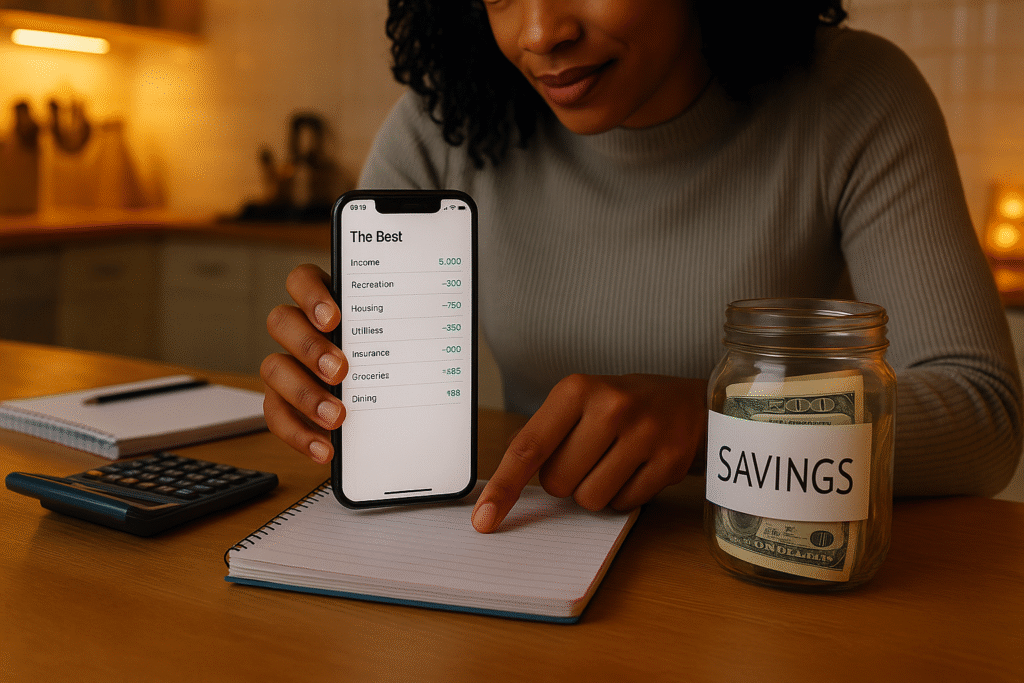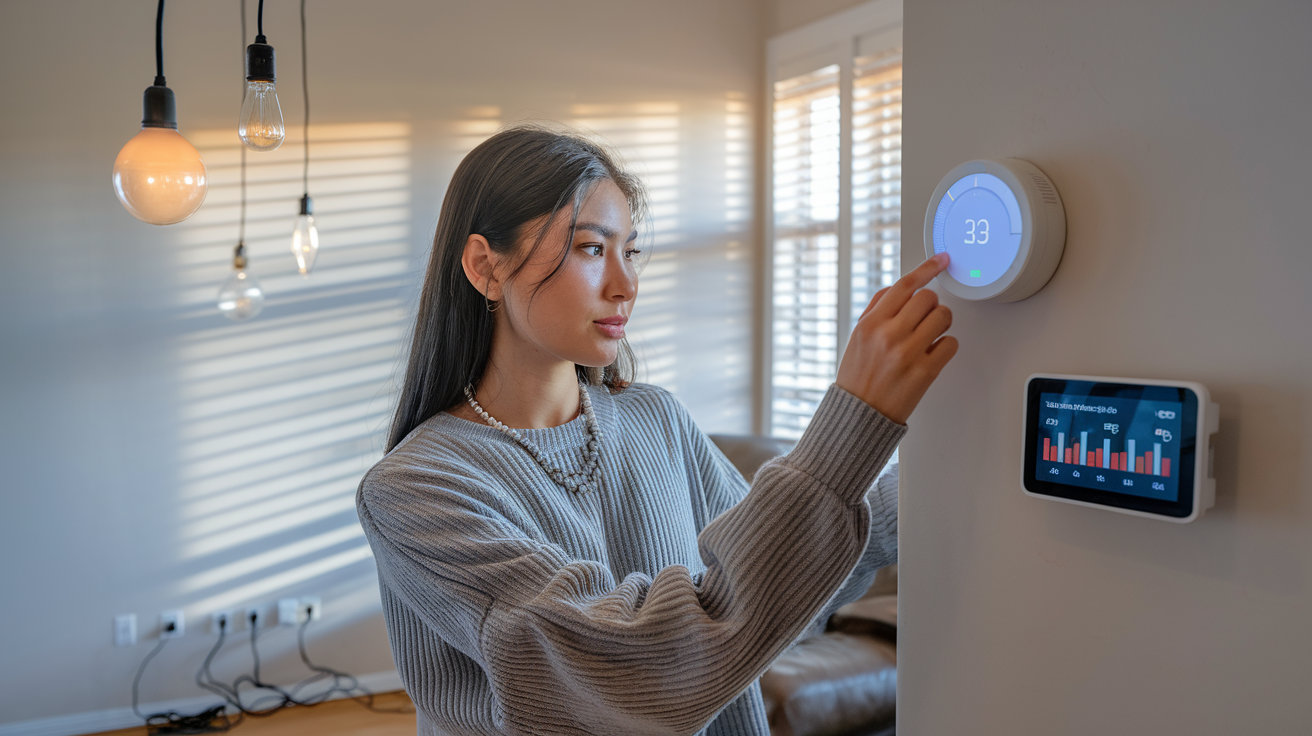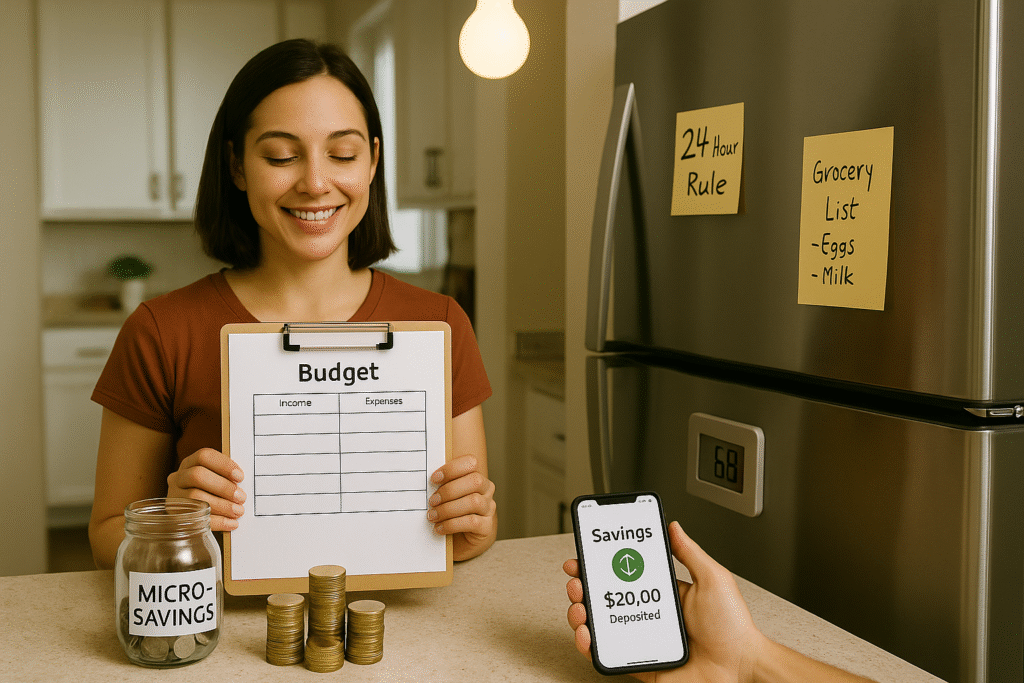I was hemorrhaging money last year without even realizing it. Just mindlessly spending as I watched my checking account dwindle, all while telling myself, “I’m not even buying anything expensive!” Turns out, unconscious overspending was silently draining my finances—little charges here and there that flew under the radar but stacked up fast. What I really needed were micro-habits to save money—tiny behavioral tweaks that seem trivial alone but add up to big financial wins over time.
Sound familiar? I bet it does.
Here’s the deal: those small daily money habits are quietly destroying your savings goals. But the opposite is also true – micro-habits can become your financial superpower.
When I finally got serious about my personal finance journey, I discovered that tiny adjustments—we’re talking 5-minute behaviors—completely transformed my bank account. Within just six months of implementing these ridiculously simple micro-habits, I had saved over $5,000. I credit a lot of my progress to tools like NerdWallet’s budget planner, which helped me get clear on where my money was actually going.
And no, I didn’t live on ramen or cancel my streaming services. The beauty of these micro-habits is how painless they are. The first one literally takes 30 seconds a day, but saved me over $1,200 alone…
The Power of Tracking Every Dollar

I was skeptical about tracking every penny I spent. It seemed tedious and, honestly, a bit obsessive. But this one habit literally saved me thousands this year, and it took less time than scrolling through Instagram each day.
A. How I created a simple 5-minute daily spending log
The key to making this work? Dead simple execution. I created a spending log that takes just 5 minutes daily:
- I keep receipts in my wallet’s designated pocket
- Every night before bed, I grab my phone and open my tracking app
- I input each expense while the day is still fresh
- I add quick notes about why I spent the money
- I review the day’s total
That’s it. Five minutes tops.
What made this stick when every other budgeting attempt failed was the simplicity. No complicated spreadsheets. No hour-long money sessions. Just a quick daily check-in that became as automatic as brushing my teeth.
B. Setting up automatic expense categorization
Manual tracking works for cash purchases, but most of my spending happens digitally. So I set up automatic categorization:
My bank and credit card transactions flow into my tracking app and get automatically sorted into categories like “Groceries,” “Entertainment,” and the dreaded “Random Amazon Purchases.” The system isn’t perfect—sometimes my coffee shop run ends up filed under “Restaurant”—but it captures about 90% accurately. Still, this kind of mindful tracking is one of those micro-habits to save money that builds long-term awareness. It’s a small financial behavior shift, but it helps me spot patterns and tighten up spending without drastic changes.
I spent about 30 minutes upfront training the system by:
- Connecting my accounts to my tracking app
- Creating custom categories that actually make sense for my life
- Setting up rules (like “Anything from Kroger = Groceries”)
- Adding merchant tags that help identify common purchases
This automation means most days I’m just confirming what the system already tracked, which takes mere seconds.
C. The psychological effect of seeing where your money goes
The numbers don’t lie, and boy, can they be uncomfortable.
Seeing that I spent $134 on takeout in a single week hit differently than just knowing I “eat out too much.” The specificity made it impossible to hide from my habits.
I noticed three immediate psychological shifts:
- The pause before purchase: “Do I want to see this on my tracker tonight?”
- The pattern recognition: “I always buy stuff online when I’m bored on Sundays”
- The satisfaction of low-spending days: They became a weird little victory
Within weeks, I started making different choices—not because I was following strict rules, but because I was finally aware of what I was actually doing with my money. That financial self-awareness was a game changer. Understanding my own money behavior patterns made it easier to make smarter, intentional decisions without feeling deprived.
D. Tools that made tracking effortless
Finding the right tools was crucial. After trying several options, these became my go-tos:
- Mint for automatic transaction importing and basic categorization
- YNAB for more intentional “give every dollar a job” planning
- A simple notes app for quick on-the-go entries
- Calendar reminders for my 5-minute evening check-in
- Pocket-sized notebook for cash transactions when I’m out
The best tool is whichever one you’ll actually use consistently. For me, mobile app accessibility was non-negotiable—if I couldn’t do it from my phone in bed, it wasn’t happening. Building micro-habits to save money starts with choosing tools that fit seamlessly into your daily routine. It’s less about the perfect app and more about establishing sustainable money-saving routines that you’ll stick with.
Implementing the 24-Hour Purchase Rule

How delaying purchases eliminated impulse buys
I used to be that person who’d see something cool online and click “buy now” without a second thought. Sound familiar?
My wallet was constantly taking hits from these random purchases. Then I stumbled onto what I now call my financial lifesaver: the 24-Hour Rule.
It’s dead simple. When I want something, I wait 24 hours before buying it. That’s it.
The first month I tried this, I saved $347 on stuff I would have bought instantly. By month three, I was saving nearly $600 monthly. The math was clear – those “small” impulse buys were actually costing me thousands annually.
What happens in those 24 hours is pretty fascinating. The emotional rush fades. The “I need this NOW” feeling disappears. About 70% of the time, I completely forget about the item altogether, which tells me how unnecessary it actually was. This delay tactic is one of those micro-habits to save money—a simple spending pause that curbs impulse buys and reinforces smarter financial behavior over time.
For bigger purchases (anything over $100), I extend this to a 72-hour rule. This stopped me from buying a $1,200 paddle board that I would have used maybe twice a year. Three days later, I realized renting one for $40 twice a year made way more sense. This approach builds on the 24-hour rule—a simple pause that often reveals what you actually need versus what you just want in the moment.
Creating a digital “want list” with price tracking
Instead of hitting “buy” right away, everything goes onto my want list. I use a simple Google Sheet with columns for:
- Item name
- Date added
- Current price
- Why I want it
- Need or want? (I’m brutally honest here)
- Alternative solutions
This isn’t just a waiting list – it’s a strategic tool. I installed price tracking extensions (CamelCamelCamel for Amazon and Honey for most other sites) that alert me when prices drop on my want-list items.
This changed everything. That $89 air fryer I almost bought? Got it for $42 during a flash sale three weeks later. The designer sneakers I was eyeing? Found them 30% cheaper from another retailer when I wasn’t in “must-buy-now” mode.
My want list also revealed surprising patterns. I noticed I add most items on Sunday evenings (bored browsing) and Wednesday afternoons (mid-week slump). Knowing this, I’m extra careful during these vulnerable times. This kind of spending habit awareness is one of the micro-habits to save money that helps me intercept emotional triggers before they morph into mindless purchases. Understanding my own consumer behavior cues has become a surprisingly effective money-saving strategy.
The surprising percentage of items I never ended up buying
Here’s the shocking truth: I never purchased 78% of the items that ended up on my want list.
I tracked 164 items over nine months. Only 36 made it to checkout. That’s potentially thousands of dollars saved on stuff that seemed essential in the moment but clearly wasn’t.
The breakdown is eye-opening:
- 42% – Completely forgot about after a few days
- 23% – Found a cheaper alternative or something I already owned
- 13% – The “need” passed (seasonal items or trend-based purchases)
- 22% – Eventually purchased (usually at a better price)
This experiment revealed something uncomfortable but important: most of my “needs” were actually just temporary wants, triggered by clever marketing, social media, or emotional shopping.
The 24-hour rule didn’t just save me money – it freed me from the constant cycle of wanting and buying. It’s probably the simplest habit change that had the biggest financial impact on my life.
Strategic Meal Planning to Slash Food Waste

My Sunday 15-minute meal planning ritual
I used to be that person who’d wander aimlessly through grocery store aisles, grabbing whatever looked good. The result? A fridge full of random ingredients and takeout receipts piling up because I couldn’t figure out what to make.
Everything changed when I started dedicating just 15 minutes every Sunday to meal planning. It’s embarrassingly simple.
Here’s what my ritual looks like:
- 5 minutes: Check what’s already in my fridge/pantry
- 5 minutes: Choose 4-5 dinner recipes for the week
- 5 minutes: Make my shopping list
I keep a magnetic notepad on my fridge where I jot down meals as I plan them. Nothing fancy, just a basic schedule like:
- Monday: Pasta with veggies
- Tuesday: Taco night
- Wednesday: Stir-fry with leftover veggies
- Thursday: Soup and salad
- Friday: Pizza night (homemade, not delivery!)
This tiny habit saves me roughly $80 a week by eliminating those “I don’t know what to eat so I’ll just order something” moments.
The inventory check that prevented duplicate purchases
Ever bought a second jar of paprika only to come home and find you already had three? Yeah, me too.
My inventory check is dead simple: before making my shopping list, I quickly scan my fridge, freezer, and pantry. I physically move items around so nothing hides in the back.
I discovered I was wasting about $30 monthly buying duplicates of:
- Spices I forgot I had
- Canned goods hiding behind other items
- Frozen vegetables buried in the freezer
- Condiments lost in the fridge door
The game-changer was organizing my pantry with clear containers so I can see exactly what I have and how much is left. For my freezer, I use a dry-erase marker to write dates on containers.
This five-minute habit saved me approximately $360 this year—money I was literally throwing away by buying things I already owned. It’s one of those micro-habits to save money that seems minor but delivers major returns. A small financial habit with big impact.
How batch cooking saved both time and money
Sunday afternoons became my secret weapon. I spend 2 hours making big batches of basics:
- A pot of beans or lentils
- Roasted vegetables
- A grain like rice or quinoa
- One protein (chicken, tofu, etc.)
These components become the building blocks for multiple meals throughout the week. When I’m tired after work, instead of ordering $25 delivery, I can throw together a healthy meal in 10 minutes using my prepped ingredients. Meal prepping not only saves money but also cuts down on stress and decision fatigue during busy weekdays.
This approach cut my food spending by about $100 weekly. That’s $5,200 annually just from this one habit!
The unexpected bonus? My batch cooking actually tastes better than most takeout, and I control exactly what goes into my food.
Converting potential food waste into creative meals
I created what I call my “Thursday Special” – a meal dedicated to using up whatever might go bad soon.
Some of my best discoveries came from these necessity-driven experiments:
- Almost-wilted spinach became amazing pesto
- Overripe bananas turned into freezer smoothie packs
- Stale bread transformed into croutons and breadcrumbs
- Veggie scraps became flavorful broth
I started keeping a “use first” bin in my fridge for items nearing expiration. This visual reminder prevents food from disappearing into the produce drawer graveyard.
This habit alone saved me roughly $20 weekly by rescuing food I previously would’ve tossed – that’s over $1,000 annually!
The apps that helped me track grocery deals
Technology became my secret weapon in this money-saving journey.
I use three apps consistently:
- Flipp: Compares all local grocery store flyers
- Ibotta: Gives cash back on specific items
- My grocery store’s app: Digital coupons and personalized deals
Before my Sunday planning, I quickly check which staples are on sale and adjust my meal ideas accordingly. If chicken is 50% off, guess what protein we’re eating that week?
By planning meals around sales rather than randomly selecting recipes, I’ve cut my grocery bill by approximately 30%.
The real insight was realizing I don’t need to visit multiple stores. I just need to know where the best deals are and adjust my plans accordingly.
These apps helped me save roughly $60 weekly—adding up to over $3,000 this year with minimal effort. They’ve become essential tools in my automated savings strategy, allowing me to grow my stash without constantly thinking about it. This kind of passive money management is one of those micro-habits to save money that builds financial momentum quietly but powerfully. It’s a low-lift, high-reward savings habit that runs on autopilot.
Automating Micro-Savings Without Feeling the Pinch

Setting up “round-up” savings on everyday purchases
Here’s the beauty of saving money without feeling it – round-up savings. I started using this micro-habit last January, connecting my debit card to an app that rounds up every purchase to the nearest dollar and tosses the change into a savings account.
Buy a coffee for $4.25? Seventy-five cents goes straight to savings.
Grab lunch for $12.40? Sixty cents saved without thinking about it.
At first, these pennies seemed insignificant. But tiny amounts add up fast when they happen automatically on every purchase. Within three months, I had saved $437 without feeling like I was budgeting at all.
The trick is setting it and forgetting it. I used Acorns initially, but most major banks now offer similar features built right into their apps. Chase, Bank of America, Wells Fargo – they all have some version of this.
What worked best for me? Setting the multiplier to 2x. Instead of just rounding up to the nearest dollar, it doubles that amount. A $3.50 purchase becomes $4.00, with $1.00 going to savings instead of just $0.50. This accelerated my savings without causing any financial strain.
The “save the change” hack that accumulated $1,200
Taking round-ups a step further, I implemented what I call the “save the change” hack. Every time I break a $20 bill and get change back, that change goes straight into a dedicated savings jar at home.
No exceptions. Get back $7.35 in change? All of it goes in the jar.
I was genuinely shocked when I counted it up after six months – $1,200 sitting there. That’s a flight to Europe I didn’t even feel myself saving for.
The psychological aspect is interesting. Cash has become rare in my daily life, so when I do use it, the change feels like a bonus rather than “real money” I’m missing out on. I’ve essentially tricked my brain into saving.
Pro tip: Don’t count the jar regularly. The surprise factor when you finally take it to the bank creates a powerful dopamine hit that reinforces the habit.
How I redirected subscription money after cancellations
We all have subscription bloat. I audited mine in February and found I was spending $147 monthly on services I barely used.
Instead of pocketing that money after cancelling, I set up an automatic transfer of the exact same amount to a high-yield savings account. Since I was already living without that money, I didn’t miss it. It’s another example of the kind of micro-habits to save money that quietly reinforce smart financial behavior—redirecting spending into saving with zero friction.
The best part? This hack works with any recurring expense you eliminate. Cancel a $15 streaming service? Set up a $15 monthly transfer to savings. Negotiate your phone bill down $20? Transfer that $20 monthly.
By June, I had redirected $882 into savings without adjusting my lifestyle one bit.
Creating automatic transfers on payday
The simplest hack became my most powerful: scheduling an automatic transfer of $50 on every payday that hit before I even saw the money.
I started small – just $50 – which is roughly the cost of two takeout meals. Once that became comfortable (took about three weeks), I bumped it to $100. Then $150.
Currently, 15% of each paycheck automatically moves to savings before I can touch it. The key is setting the transfer for the exact moment your paycheck hits. No willpower required.
After doing this for a year, I’ve saved $2,481 through this method alone. Combined with the other micro-habits, I’ve painlessly saved over $5,000 without feeling deprived.
Energy-Saving Micro-Habits That Added Up

The 5-minute evening power-down routine
You know what bugs me? Walking around my house the next morning and seeing all those little standby lights glowing back at me. Each one silently saying, “Yeah, I’ve been sipping electricity all night while you slept.”
So I created this ridiculously simple routine that takes just 5 minutes before bed. I grab my phone (flashlight on) and do a quick sweep through the main living areas. TV off at the wall. Coffee maker unplugged. Laptop chargers disconnected. Gaming console powered down completely. It’s a nightly version of the phantom energy check, and it’s shaved noticeable dollars off my electric bill every month.
The results shocked me. My electric bill dropped by $21 the very first month. That’s $252 a year just for taking a 5-minute walk before bedtime!
The key is making it automatic. I keep a small checklist on my phone of the top energy vampires in my home:
- Entertainment center (that sneaky soundbar!)
- Kitchen counter gadgets
- Home office equipment
- Bathroom appliances
What really makes this stick? I paired it with something I already do every night—brushing my teeth. Power-down sweep, then teeth. Now it’s just part of going to bed.
Installing smart plugs in high-usage areas
Smart plugs might be the laziest way possible to save money, and I’m here for it.
I identified the three areas where I have clusters of electronics: my entertainment center, home office, and kitchen counter. Instead of individually unplugging everything (or forgetting half of them), I grouped devices onto smart plugs.
Here’s the setup that’s saving me roughly $18/month:
| Location | Devices Connected | Monthly Savings |
|---|---|---|
| Living Room | TV, sound system, game console | ~$8 |
| Home Office | Computer peripherals, printer, desk lamp | ~$6 |
| Kitchen | Coffee maker, toaster, blender | ~$4 |
The magic happens with scheduling. My living room stuff automatically cuts power at midnight and turns back on at 5pm. Office equipment shuts down at 8pm and powers up at 7am.
Beyond the scheduling, I added the smart plug controls to my phone’s home screen. One tap and everything’s off when I leave the house. The convenience factor made this habit stick where my previous attempts failed.
And yes, you can find smart plugs for under $10 each if you catch a sale. Mine paid for themselves in less than two months.
The shower timer trick that cut my water bill
I used to take 15-minute showers without thinking twice. Hot water just feels good, right? But then I saw my water bill and nearly slipped in the shower.
So I tried a little experiment. I bought a waterproof digital timer for $8 and stuck it to my shower wall. The goal? Cut my shower time to 7 minutes.
I failed miserably the first week. Turns out I was spending almost 5 minutes just standing there, zoning out under the hot water. But the timer made me aware of it.
By week three, I was hitting 7 minutes consistently. My trick? I turned it into a game—trying to beat yesterday’s time while still getting properly clean.
The numbers don’t lie. My water bill dropped by $14 monthly, and my energy bill went down about $11 from heating less water. That’s around $300 yearly from just watching a timer while I shampoo. It’s proof that even tiny micro-habits to save money—like shortening your shower—can cascade into substantial financial wins. A small lifestyle tweak, big savings ripple.
Extra tip: I installed a low-flow showerhead that still feels high-pressure. That combo—shorter showers plus efficient hardware—is what really amplified the savings.
How adjusting my thermostat by just 2 degrees made a difference
Small changes compound in surprising ways. Case in point: I adjusted my thermostat by just 2 degrees—cooler in winter (68°F instead of 70°F) and warmer in summer (76°F instead of 74°F).
I barely noticed the difference day-to-day, especially after:
- Adding an extra blanket to the bed in winter
- Positioning a small fan strategically in summer
- Wearing appropriate clothes for the season (novel concept, I know)
But my energy bill definitely noticed. I saved approximately $38 monthly during winter months and $42 during peak summer. That’s roughly $320 over the year.
The clever part was using a programmable thermostat to automatically adjust temperatures when I’m sleeping or away. While I’m at work, the temperature shifts another 3-4 degrees, then returns to my “comfort zone” 30 minutes before I get home.
What makes this so effective is that heating and cooling typically account for about 50% of most home energy bills. A tiny adjustment affects a huge expense category.
The best part? Unlike some money-saving habits that feel like sacrifice, after the first week, I completely stopped noticing the temperature difference.
Final Thoughts

Building wealth isn’t always about dramatic lifestyle changes—sometimes it’s the small, consistent actions that deliver the biggest results. By tracking every dollar, embracing the 24-hour purchase rule, planning meals strategically, automating micro-savings, and implementing energy-saving habits, you can transform your financial situation without feeling deprived. These five micro-habits helped me save $5,000 this year, proving that mindful money management happens in moments, not marathons.
Start with just one of these micro-habits this week and gradually add more as each becomes second nature. The beauty of these approaches is their simplicity and sustainability—they work because they’re practical enough to maintain long-term. Your future self will thank you for these small decisions that compound into significant savings over time. What $5,000 opportunity is waiting for you through these simple daily choices? Looking for more actionable advice? Head to the Investillect blog.

